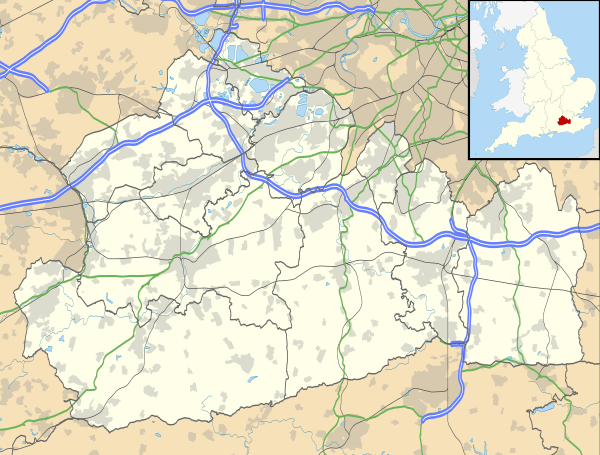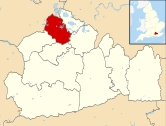Wentworth Estate
| Wentworth Estate | |
_by_George_Frederick_Prosser.jpg) View of Portnall Park, from the south-east, published in 1828. Once the home Colonel Bisse-Challoner, it is now known as the Dormy House. The cluster of sheep have been replaced by a Wentworth golf course fairway. |
|
 Wentworth Estate |
|
| Population | less than 2,000 |
|---|---|
| OS grid reference | SU9867 |
| District | Runnymede |
| Shire county | Surrey |
| Region | South East |
| Country | England |
| Sovereign state | United Kingdom |
| Post town | Virginia Water |
| Postcode district | GU25 |
| Dialling code | 01344 |
| Police | Surrey |
| Fire | Surrey |
| Ambulance | South East Coast |
| EU Parliament | South East England |
| UK Parliament | Runnymede and Weybridge |
Coordinates: 51°23′49″N 0°35′02″W / 51.397°N 0.584°W
The Wentworth Estate is a 1920s-founded estate of houses and woodland across 7 square kilometres (2.7 sq mi) (a typical small village size in England) around the home of the first Ryder Cup, Wentworth Club. It is in Virginia Water, Surrey, England and forms one of Europe's premier residential areas on a gently undulating area of coniferous heath, a nationally rare soil type. Most of its invariably large plots have homes built from scratch or rebuilt after 1930 in a range of styles from the ornate multi-chimneyed Arts and Crafts movement of the earliest properties through Neo-Georgian and colonial revival to the postmodern simple style as in the recording studios at John Lennon's Tittenhurst Park (1971) in the adjoining parish of Sunninghill and Ascot, the north of which, with parts of Windsor, Winkfield and Virginia Water is the main piece of Crown Estate in South-East England, Windsor Great Park.
History
The 19th-century house the "Wentworths" (now the club house for the Wentworth Club) was the home of a brother-in-law of the 1st Duke of Wellington. It was purchased in 1850 by the exiled Spanish count Ramon Cabrera, and after his death his wife bought up the surrounding lands which were later to form the nucleus of the Wentworth Estate.[1]
In 1912, builder W.G. Tarrant had started developing St George's Hill, Weybridge – a development of houses based on minimum 1-acre (0.40 ha) plots based around a golf course. In 1922 Tarrant acquired the development rights for the Wentworth Estate, getting Harry Colt to develop a golf course around the "Wentworth" house. Tarrant developed the large houses on the estate to a similar Surrey formula used at St George's Hill – tall chimneys, dormer windows, gables, leaded lights, tile-hung or half-timbered or a combination of both; most using hand-made bricks and tiles. Some houses had stonework round the front door and stone fireplaces, a few had a marble floor in the hall, and the rarest – of which he was most proud – had a stone tablet with his initials WGT.[2]
Development of Wentworth Estate ground to a halt due to depression in the late 1920s, and in 1931 when the banks asked for repayment of a large debenture, Tarrant was forced to declare bankruptcy. The ownership of the land passed to Wentworth Estates Ltd, which came under the control of Sir Lindsay Parkinson & Co Ltd. Construction picked up in the late 1930s, with many houses built by Tarrant Builders Ltd, with Tarrant's son Percy as one of the directors; but again stopped during World War II when the need arose to build high-density housing close to Virginia Water railway station.[3]
Post-war development picked up considerably, and by 1960 most of the available land was already used.
Planning and amenities
In 1962, a committee of residents and the company promoted a private act of Parliament, and on 31 July the Wentworth Estate Act was given Royal assent. The Act established the Wentworth Estate Roads Committee, which appoints its members on advice from the Wentworth Residents' Association.[4]
The Wentworth Estate is laid out across 700 hectares (1750 acres) and forms one of Europe's premier residential areas.[5] Within the estate borders are a mixture of public and private roads, footpaths and open areas. It adjoins along a long border the long row of its village's shops, restaurants and other amenities, which is laid out upon similar lines but has many 21st century converted mansion and newly built apartments.[6]
The River Bourne runs through the area which has a population of 5,895.[7]
Transport
- Road
Wentworth is just outside the ring of the London Orbital with a junction 3 miles (4.8 km) north. Routes from the west of the estate lead into Berkshire and towards Camberley and the Bagshot junction of the M3, which links to Southampton and to the A303.
- Rail
Wentworth is adjoined to its south and east by a major stop and minor stop railway station on the London Waterloo to Reading Line: Virginia Water and Longcross respectively.
- Air
Wentworth is 7 miles (11 km) south-west of Heathrow Airport; in private aviation Fairoaks Airport is 5 miles (8.0 km) south, accessible through Lyne and Ottershaw.
Residents
The estate hit the headlines in 1998 when former Chilean president General Augusto Pinochet was kept under house arrest in one of its houses prior to his extradition.[8][9]
- Peter Aven – Russian banker[10] formerly Vijay Mallya's residence.
- Thomas Bjørn – golfer
- Sultan of Brunei[11]
- Ernie Els – golfer[12]
- Bruce Forsyth – entertainer
- Wilnelia Merced, Lady Forsyth-Johnson 1975 Miss World, the only Puerto Rican to win the title.
- Gary Numan – musician
- Bryan Forbes – Actor and film director.
- Prince Naseem Hamed Former Boxing world champion
- Eddie Jordan Head of former Jordan F1 Team
- Ron Dennis British Business Ambassador for UK Trade & Investment, owner of Absolute Taste, majority owner and CEO of McLaren Group and all of its companies including the formula one team, technology company and electronics company and minority owner, CEO and chairman of McLaren Automotive.
Former residents
- Russ Abbot – entertainer
- Boris Berezovsky – Oligarch[13]
- Diana Dors – actress
- Elton John – musician
- Augusto Pinochet, former President of Chile[14]
- Prajadhipok, abdicated king of Thailand[15]
- Cliff Richard – singer[16]
- Sarah, Duchess of York
- Andriy Shevchenko – striker for Chelsea F.C.[10]
- Herbert Bradfield – MOD, Military Vehicles Engineering Establishment (MVEE)
- Arthur Clutterbuck – coal miner and part time communist from Merthyr Tydfil who went back to Merthyr in protest at Pinochet being moved in next door.
Kevin pietersen – English cricketer.
References
- ↑ Archives Network Wales – The de Morella Collection
- ↑ Books, Research and Information – Arts & Crafts Home
- ↑ BBC – WW2 People's War – It was totally different
- ↑ Wentworth Estate – History
- ↑ BBC NEWS | England | Surrey | Priciest street outside of London
- ↑ Wentworth Estate
- ↑ Census data
- ↑ BBC News | World | Pinochet retreats to luxury estate
- ↑ Pinochet , General Augusto, Archive news
- 1 2 Safe as houses: the KGB-proof mansion Sunday Times – 6 May 2007
- ↑ unofficial-guides.com – Royal Holloway
- ↑ Time for something Els | Golf | Guardian Unlimited Sport
- ↑ Moscow on the Thames The Telegraph
- ↑ Pinochet retreats to luxury estate
- ↑ Compton House, Lake Road, Wentworth Estate, Surrey, accessed 3 March 2015
- ↑ Cliff becomes a bungalow boy the Daily Mail
External links
| Wikimedia Commons has media related to Wentworth Estate. |
